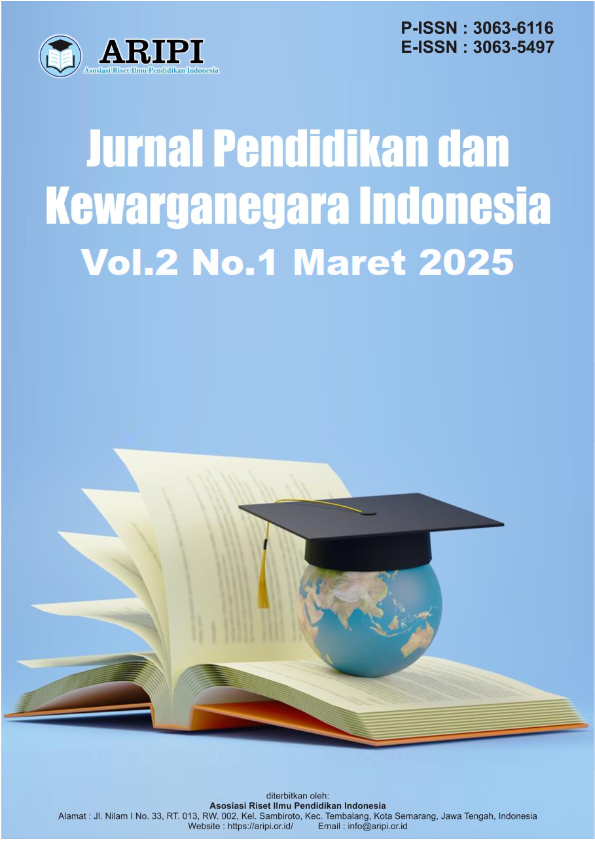Analisis Motivasi Belajar Siswa Pada Pembelajaran Bahasa Indonesia Menggunakan Media Pembelajaran Papan Pantun Siswa Kelas IV SD Negeri 101744 Desa Klambir T.A 2023/2024
DOI:
https://doi.org/10.61132/jupenkei.v2i1.177Keywords:
Student learning motivation, Pantun board learning media, IndonesianAbstract
The results of observations and research on November 06 2023 are about students' learning motivation in learning Indonesian using pantun board media. The research method used is a descriptive quantitative method and uses nominal questionnaire data which only contains simultaneous results and facts from the truth produced by the researcher. From the results of this research, the student data obtained was 23 (twenty three) students and it was found that 3 (three) of the 23 (twenty three) students in class IV of SD Negeri 101744 Klambir Village had low motivation and interest in learning in particular learning. Indonesian language. The aim of this research is to describe students' learning motivation in learning Indonesian in class IV. The method used in this research is descriptive quantitative research. Meanwhile, data collection techniques include observation, interviews, questionnaires and documentation. This process is carried out by collecting data directly at the research location. Next, the data analysis process was carried out on a nominal scale only. This research uses source triangulation techniques. From the results of data analysis, it is known that students' learning motivation in learning Indonesian in class IV of SD Negeri 101744 Klambir Village is still low, as can be seen from the low interest of students in learning Indonesian both in class and at home, as evidenced also by the results of the assessment of the distributed questionnaire data, which shows that some class IV students got grades that were less than expected, and this was due to several factors, namely 1). Self factor 2). Environmental factors 3). Family factors. The impact of the causes of low student learning motivation internally is due to a lack of motivation in their enthusiasm for learning and externally due to 1). Teacher performance 2). Infrastructure 3). Surrounding environment.
References
Adi, Y. K., & Dkk. (2014). Studi komparasi pembelajaran kooperatif tipe Numbered Heads Together (NHT) dilengkapi Macromedia Flash dan handout terhadap prestasi belajar siswa pada materi koloid kelas XI di SMA N 1 Karanganyar tahun ajaran 2012/2013. Jurnal Pendidikan Kimia (JPK), 3(2).
Agusdwitanti, H., Tambunan, S. M., & Retraningsih. (2015, Juni). Kelekatan dan intimasi pada dewasa awal. Jurnal Psikologi, 8(1), 18-19.
Agustina, E., & Dkk. (2013). Penggunaan metode pembelajaran jigsaw berbantuan handout untuk meningkatkan aktivitas dan prestasi belajar siswa pada materi pokok hidrokarbon kelas XC SMA Negeri 1 Gubug tahun ajaran 2012/2013. Jurnal Pendidikan Kimia (JPK), 2(4).
Basrowi. (2014). Pengantar sosiologi. Ghalia Indonesia.
Departemen Pendidikan Nasional. (2006). Kurikulum tingkat satuan pendidikan (KTSP) untuk sekolah dasar/MI. Depdiknas.
Komariah, A., & Satori, D. (2011). Metode penelitian kualitatif. Alfabeta.
Miles, M. B., Huberman, A. M., & Saldana, J. (2014). Qualitative data analysis: A methods sourcebook (3rd ed.). Sage Publications.
Nawawi, H. (2005). Penelitian terapan. Gajah Mada University Press.
Rahmawati, R. (2016). Faktor-faktor yang mempengaruhi motivasi belajar siswa kelas X SMA Negeri 1 Piyungan pada mata pelajaran ekonomi.
Sardiman, A. M. (2018). Interaksi dan motivasi belajar mengajar. Rajawali Pers.
Soemanto, W. (2003). Psikologi pendidikan. Rineka Cipta.
Sugiyono. (2009). Metode penelitian kuantitatif, kualitatif dan R&D. Alfabeta.
Sukmadinata, N. S. (2011). Landasan psikologi proses pendidikan. Remaja Rosdakarya.
Wahab, R. (2015). Psikologi belajar. Rajawali Pers.









